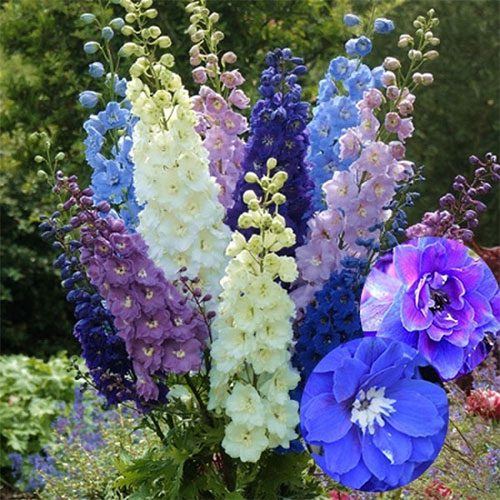Delphinium flowers are a popular imported flower that has gained popularity in recent years. They are known for their durability and variety of colors, making them a favorite for home decoration.
According to scientist and herbalist Bui Duc Sang from the Vietnam Academy of Science and Technology (Hanoi Oriental Medicine Association), the scientific name for delphinium flowers is Delphinium Acis L. This flower is also known by various names such as bird’s foot or eastern herb. Delphinium is quite popular and beloved in European countries. In Vietnam, it is primarily cultivated in Da Lat.
The delphinium plant is known for its vigorous growth and symbolizes resilience, yet it also possesses a gentle and pure quality. Delphinium flowers come in a variety of colors including white, pink, red, purple, and blue, making them a preferred choice for important occasions.

Delphinium Flowers. (Image source: Internet).
Scientist Bui Duc Sang warns that while delphinium flowers are beautiful, they are toxic and should be handled with caution. This plant contains toxins throughout its body and has been known to cause the death of animals such as sheep.
Since the time of the Pharaohs, delphinium has been regarded as an important plant used for making pesticides. In India, people use the seeds of delphinium as insecticides.
Scientist Bui Duc Sang further explains: “Delphinium flowers contain diterpenoid alkaloids, including methyllycaconitine, which is highly toxic. Alkaloids are poisonous substances found abundantly in delphinium; even a small amount can cause vomiting, while a larger quantity can lead to death.”
The U.S. Department of Agriculture warns that all delphinium species (Delphinium Ajacis, Larkspur) contain diterpene alkaloid toxins. This substance inhibits the nervous system, causing muscle paralysis, including that of the heart, which can be fatal if consumed in sufficient quantities. In North America, delphinium is a leading cause of livestock losses in western regions, particularly in mountainous areas.
According to scientist Bui Duc Sang, the delphinium plant is most toxic during its early growth stages, with toxicity decreasing as it matures. The highest concentration of toxins in the delphinium is found in the flowers, seeds, and fruits.
Consumption of just 2 mg of alkaloids can be fatal for adults. Children may experience severe dermatitis upon contact with the flowers or exhibit poisoning symptoms if ingested.
Scientist Bui Duc Sang advises that despite the beauty of delphinium flowers, they should not be displayed indoors because ingestion by children or pets can lead to poisoning and health issues. If these flowers must be arranged indoors, they should be placed out of reach of small children and pets.
For handling toxic flowers, experts recommend wearing gloves to avoid sap contact with the skin. After arranging flowers, hands should be thoroughly washed.


















































